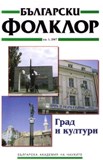Градски култури, градски идентичности
Urban Cultures, Urban Identities
Author(s): Irena BokovaSubject(s): Anthropology
Published by: Институт за етнология и фолклористика с Етнографски музей при БАН
Summary/Abstract: The reflections and speculations in this article result from observations in the towns of Pisa and Livorno, as well as of continuous fieldwork in Plovdiv and Asenovgrad in the context of new spaces created within the framework of the European Union. Pisa and Plovdiv count on their images as towns of art and historical past with their own input in the development of the European. Plovdiv is a town of painters, or Bohemian artists, forming tendencies in the modem art of Bulgaria. Pisa as a “town of art and history” attracts historians of culture, art specialists and connoisseurs being a part of the development of the arts in Europe. The ideas of contacts with other cultures are “marked” as the specific feature in the works – creations of human genius. Livorno and Asenovgrad put the accent on culture as way of life and try to find grounds for the invention of images of culture as art in the creation of urban identities. In general, however, it is the contact with others, the co-existence of the different in the course of centuries, which is re-interpreted and outlined as a basic fact, significant for the images of the town. Even when it has become “already history” (Livorno and the regime of Mussolini, Asenovgrad and the migrants’ waves). The “new” urban identities result from newly constructed territories and re-projected historical bonds. Neighbourhood as reality and imaginary gives new significance to spaces creates new territory entities. The historically formed experience of “living” territories, the cultures as ways of life generate resources on symbolic level, which could be used and become a part of the consumer culture by offering products with the label “authentic”. The cultures and experiences are also a part of the symbolic resource for maintaining the bonds of the citizens with their place of living, and for value re-interpretation of the urban and its historical projections. The examples from Italy point at thinking of cultures and people, cultures and territories, people and territories in their dynamic connection without searching for definite and stable borders in space and time. The Bulgarian examples point at thinking on the level of the separate, the independent, within its own borders, in the comfort of the familiar and the stable. However, the cultural techniques of constructing identities show common tendencies implying dialogue and complimentary correlation between Culture as civilization, as arts, in its universal dimensions, and cultures as local configurations, as specific cultural combinations. The differences refer to the levels of thinking the universal and the specific, the local in the context of Europe – new or “anew”.
Journal: Български фолклор
- Issue Year: XXXIII/2007
- Issue No: 1
- Page Range: 5-24
- Page Count: 20
- Language: Bulgarian
- Content File-PDF

